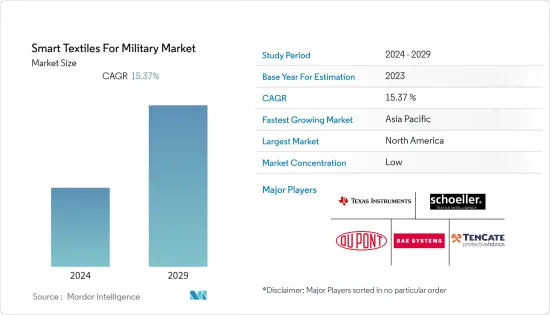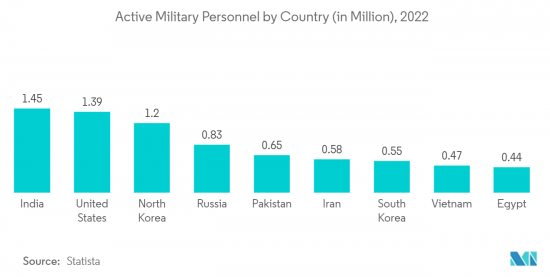 |
市場調查報告書
商品編碼
1404073
軍用智慧紡織品 -市場佔有率分析、產業趨勢/統計、2024-2029 年成長預測Smart Textiles For Military - Market Share Analysis, Industry Trends & Statistics, Growth Forecasts 2024 - 2029 |
||||||
※ 本網頁內容可能與最新版本有所差異。詳細情況請與我們聯繫。
軍用智慧紡織品市場2024年市場規模為7.6億美元,預計2029年將達15.6億美元,預測期內複合年成長率為15.37%。

由於材料科學、奈米技術、穿戴式電子產品的進步以及對提高士兵性能和安全性的需求不斷增加,軍用智慧紡織品市場正在經歷顯著的成長和創新。現代軍隊尋求為士兵配備先進的系統,以提高他們的情境察覺、生存能力和戰場上的整體效能。穿戴式感測器和健康監測系統的整合可以即時追蹤生命徵象並及早發現潛在的健康問題。感測器小型化、能源採集、資料分析和通訊技術的快速技術進步推動了市場的發展。
主要企業都積極參與將穿戴式電子設備和感測器整合到軍事裝備中的計劃,並專注於先進的士兵系統。公司開發用於軍事應用的高性能材料和織物,例如防護衣和智慧制服。該公司還投資於研發,重點是將通訊系統、生物識別感測器和能源採集技術整合到士兵的裝備中。
軍用智慧紡織品市場趨勢
健康監測診斷領域佔市場主導地位
健康監測和診斷領域預計將在預測期內引領市場。國防支出的增加和對改善士兵安全的日益關注正在推動市場成長。軍事人員長期在惡劣的地形中作戰,需要保護免受自然因素和戰鬥危險的影響。生物和化學製劑因其整體防禦和進攻潛力而繼續構成嚴重威脅。由於擔心恐怖分子和民兵組織等非國家武裝團體可能使用生技藥品攻擊空氣和水源、糧食供應和其他關鍵基礎設施,生物恐怖主義的威脅最近有所增加。
此外,透過將物聯網感測器整合到智慧服裝中來確定環境中有害氣體的存在和水平,軍方可以有效減少有害氣體造成的損害。美國公司 Acellent Technologies Inc. 與美國合作開發了 SmartArmor 系統,用於監測防護衣結構在運作中的健康狀況。該系統由智慧型層和軟體組成,旨在監控個人防護衣並提高戰區士兵的安全。
此外,截至 2022 年 5 月,美國研究人員正在致力於開發可整合到製服中的穿戴式氣體感測器。用於軍事應用的靈活、多孔且靈敏的二氧化氮感測器可監測戰場上以及危險氣體爆發期間士兵的健康和安全。
2022 年 12 月,美國選擇了 24 家小公司開發先進的穿戴式技術,以滿足當前和未來的戰鬥需求。這些公司將在第一階段小型企業創新研究合約中獲得 15 萬美元。這是為了開發能夠感知和監測即時生理資料的設備,以評估作戰人員的健康狀況和戰備情況。預計多種技術先進產品的研發將在預測期內推動該細分市場顯著成長。

預計亞太地區在預測期內將顯著成長。
由於國防預算不斷增加、地緣政治緊張局勢以及對士兵安全和表現的日益關注,亞太地區有望引領市場。該地區快速的技術進步、繩索紡織品製造基地和協作努力也有助於其在採用和開發軍事應用創新智慧紡織品解決方案方面的優勢。此外,該地區的一些國家正在強調關鍵國防技術的國內生產和自給自足,並正在促進本土智慧紡織品解決方案的研究、開發和採用。
2022 年 5 月,Soliyarn, Inc. 與韓國領先的紡織品製造公司 Huvis Global 以及馬薩諸塞州 M2I2 製造補貼計劃簽署協議,完成了 770 萬美元的資金籌措。這將為大規模生產智慧紡織品的研發和生產設施奠定基礎。
例如,2022年9月,印度理工學院(IIT)宣布與印度政府公司Troop Comforts Limited(TCL)簽署合作備忘錄,為印度安全部隊開發智慧防護衣。
2022年5月,澳洲國防部開始推出澳洲皇家海軍的新海服。該制服是與墨爾本工作服集團和布魯克紡織集團合作開發的,其布料具有固有的阻燃性。然而,為印度、日本和其他國家的軍隊開發智慧紡織品的研究活動的成長預計將在預測期內推動市場成長。
軍用智慧紡織產業概況
軍用智慧紡織品市場被許多企業瓜分。市場上一些知名的公司包括 BAE Systems plc、德州儀器公司、TenCate Protective Fabrics、Dupont de Nemours Inc. 和 Schoeller Textil AG。
該市場的公司正在與歐洲和北美的多所大學和研究機構合作,為世界軍隊開發先進的智慧紡織品。此外,該公司還與政府和軍方合作,為軍事人員生產客製化產品。市場正在興起,技術進步空間巨大。隨著多個國家認知到智慧紡織品在戰場上的重要性,預計許多國家將進行大量研發投資,這可能會在預測期內為當地企業提供新的機會。
其他福利:
- Excel 格式的市場預測 (ME) 表
- 3 個月分析師支持
目錄
第1章簡介
- 調查先決條件
- 調查範圍
第2章調查方法
第3章執行摘要
第4章市場動態
- 市場概況
- 市場促進因素
- 市場抑制因素
- 波特五力分析
- 供應商的議價能力
- 買家/消費者的議價能力
- 新進入者的威脅
- 替代品的威脅
- 競爭公司之間敵對關係的強度
第5章市場區隔
- 按用途
- 偽裝
- 能量收穫
- 溫度監控與控制
- 保護和機動性
- 健康監測和診斷
- 按地區
- 北美洲
- 美國
- 加拿大
- 歐洲
- 英國
- 法國
- 德國
- 俄羅斯
- 歐洲其他地區
- 亞太地區
- 中國
- 印度
- 日本
- 韓國
- 其他亞太地區
- 拉丁美洲
- 巴西
- 墨西哥
- 其他拉丁美洲
- 中東/非洲
- 阿拉伯聯合大公國
- 沙烏地阿拉伯
- 土耳其
- 南非
- 其他中東/非洲
- 北美洲
第6章競爭形勢
- 公司簡介
- BAE Systems plc
- TenCate Protective Fabrics
- WL Gore & Associates Inc.
- Milliken & Company
- Schoeller Textil AG
- Dupont de Nemours Inc.
- Bebop Sensors
- Noble Biomaterials Inc.
- Mide Technology Corporation
- Advanced Fabric Technology LLC
- Seyntex
- MMI Textiles.
- Outlast Technologies LLC
- Texas Instruments(TI)
第7章 市場機會及未來趨勢

The Smart Textiles for Military market was valued at USD 0.76 billion in 2024 and is projected to reach USD 1.56 billion by 2029, registering a CAGR of 15.37% during the forecast period.
The smart textiles for the military market are experiencing significant growth and innovation, driven by advancements in material science, nanotechnology, wearable electronics, and increasing demand for enhanced soldier performance and safety. Modern militaries are looking to equip their soldiers with advanced systems to enhance their situational awareness, survivability, and overall effectiveness on the battlefield. The integration of wearable sensors and health monitoring systems enables real-time tracking of vital signs and early detection of potential health issues. Rapid technological advancements in sensor miniaturization, energy harvesting, data analytics, and communication technologies drove the market.
Key players are actively involved in projects focusing on advanced soldier systems, integrating wearable electronics and sensors into military gear. Companies are developing high-performance materials and fabrics used in military applications, including protective gear and smart uniforms. Companies are also investing in R&D to focus on integrating communication systems, biometric sensors, and energy harvesting technologies into soldier equipment.
Military Smart Textiles Market Trends
Health Monitoring and Diagnostics Segment to Dominate the Market
The health monitoring and diagnostics segment is projected to lead the market during the forecast period. An increase in defense expenditure and a rising focus on improving soldiers' security drive the growth of the market. The operation of military personnel in harsh terrains for extended tenure necessitates protection from elements and battle hazards. Biological and chemical agents continue to pose severe threats because of their overall defensive and offensive potential. Recently, the threat of bioterrorism increased due to concerns that non-state armed actors, such as terrorists and militia groups, could use biological agents to target air and water sources, food supplies, and other vital infrastructures.
Additionally, integrating IoT sensors in smart clothes to determine the presence and level of hazardous gas in the environment allows the military to efficiently mitigate the harm caused by dangerous gases. Acellent Technologies Inc., a US company, in collaboration with the US Army, developed the SmartArmor system for the in-service monitoring of the health of body armor structures. The system was designed to monitor personal body armor comprising an intelligent layer and software to increase the safety of soldiers in a combat zone.
Furthermore, as of May 2022, researchers in the US worked on wearable gas sensors integrated with uniforms. The flexible, porous, and susceptible nitrogen dioxide sensors for military applications monitor the soldier's health and safety on the battleground or in case of hazardous gases.
In December 2022, the US Army selected 24 small companies to develop advanced wearable technologies to address current and future warfighting needs. These companies each will receive USD 150,000 as Phase I Small Business Innovation Research contracts. It is for developing a device capable of sensing and monitoring real-time physiological data to assess warfighter's health and readiness. Several technologically advanced product research and developments are expected to drive this market segment at significant growth rates during the forecast period.

The Asia-Pacific Region is Expected to Witness Significant Growth During the Forecast Period.
The Asia-Pacific region is poised to lead the market due to increasing defense budgets, geopolitical tensions, and a growing focus on soldier safety and performance. The region's rapid technological advancements, string textile manufacturing base, and collaborative efforts also contribute to its dominance in adopting and developing innovative smart textile solutions for military applications. Moreover, some countries in the region are emphasizing domestic production and self-sufficiency in critical defense technologies, driving local research, development, and adoption of homegrown smart textile solutions.
In May 2022, Soliyarn, Inc. signed a deal with Huvis Global, a South Korean fiber manufacturing giant, and the Commonwealth of Massachusetts, M2I2 Manufacturing Grant program to close a round of funding for USD 7.7 million. It will lay the groundwork for a research & development and production facility to manufacture smart textiles at scale.
For instance, in September 2022, the Indian Institute of Technology (IIT) announced they signed a memorandum of understanding with Troop Comforts Limited (TCL), an enterprise of India's government for developing Smart Protective Clothing for the Indian security forces.
In May 2022, the Australian Department of Defense started the rollout of the Royal Australian Navy's new maritime uniform. This uniform was developed by partnering with Workwear Group, Melbourne, and Bruck Textiles Group and is incorporated with inherent fire-retardant properties within the fabric. Nevertheless, the growth in research activities to develop smart textiles for the militaries of countries like India, Japan, and others is expected to drive market growth during the forecast period.
Military Smart Textiles Industry Overview
The smart textile for the military market is fragmented due to many players. Some prominent players in the market are BAE Systems plc, Texas Instruments Incorporated, TenCate Protective Fabrics, Dupont de Nemours Inc., and Schoeller Textil AG.
Players in the market collaborated with several universities and research organizations in Europe and North America to develop advanced smart textiles for global militaries. Moreover, companies are partnering with governments and armed forces to build customized products for their military personnel. The market is emerging, with a lot of scope for technological advancements. Since several countries realize the importance of smart textiles on the battlefield, significant R&D investments are anticipated from many countries, which may provide new opportunities for local players during the forecast period.
Additional Benefits:
- The market estimate (ME) sheet in Excel format
- 3 months of analyst support
TABLE OF CONTENTS
1 INTRODUCTION
- 1.1 Study Assumptions
- 1.2 Scope of the Study
2 RESEARCH METHODOLOGY
3 EXECUTIVE SUMMARY
4 MARKET DYNAMICS
- 4.1 Market Overview
- 4.2 Market Drivers
- 4.3 Market Restraints
- 4.4 Porter's Five Forces Analysis
- 4.4.1 Bargaining Power of Suppliers
- 4.4.2 Bargaining Power of Buyers/Consumers
- 4.4.3 Threat of New Entrants
- 4.4.4 Threat of Substitute Products
- 4.4.5 Intensity of Competitive Rivalry
5 MARKET SEGMENTATION
- 5.1 By Application
- 5.1.1 Camouflage
- 5.1.2 Energy Harvest
- 5.1.3 Temperature Monitoring and Control
- 5.1.4 Protection and Mobility
- 5.1.5 Health Monitoring and Diagnostics
- 5.2 By Geography
- 5.2.1 North America
- 5.2.1.1 United States
- 5.2.1.2 Canada
- 5.2.2 Europe
- 5.2.2.1 United Kingdom
- 5.2.2.2 France
- 5.2.2.3 Germany
- 5.2.2.4 Russia
- 5.2.2.5 Rest of Europe
- 5.2.3 Asia-Pacific
- 5.2.3.1 China
- 5.2.3.2 India
- 5.2.3.3 Japan
- 5.2.3.4 South Korea
- 5.2.3.5 Rest of Asia-Pacific
- 5.2.4 Latin America
- 5.2.4.1 Brazil
- 5.2.4.2 Mexico
- 5.2.4.3 Rest of Latin America
- 5.2.5 Middle East and Africa
- 5.2.5.1 United Arab Emirates
- 5.2.5.2 Saudi Arabia
- 5.2.5.3 Turkey
- 5.2.5.4 South Africa
- 5.2.5.5 Rest of Middle East and Africa
- 5.2.1 North America
6 COMPETITIVE LANDSCAPE
- 6.1 Company Profiles*
- 6.1.1 BAE Systems plc
- 6.1.2 TenCate Protective Fabrics
- 6.1.3 W.L. Gore & Associates Inc.
- 6.1.4 Milliken & Company
- 6.1.5 Schoeller Textil AG
- 6.1.6 Dupont de Nemours Inc.
- 6.1.7 Bebop Sensors
- 6.1.8 Noble Biomaterials Inc.
- 6.1.9 Mide Technology Corporation
- 6.1.10 Advanced Fabric Technology LLC
- 6.1.11 Seyntex
- 6.1.12 MMI Textiles.
- 6.1.13 Outlast Technologies LLC
- 6.1.14 Texas Instruments (TI)







